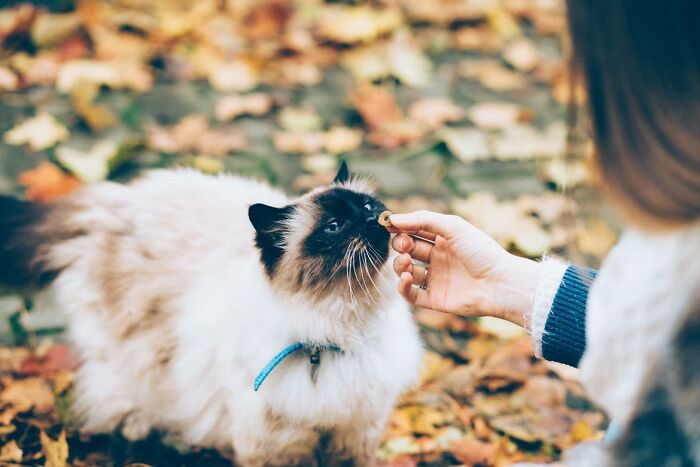If you own a cat, you probably never get bored. Looking at them pouncing, bouncing, stalking, and purring is a source of entertainment right there. And if we have to name a few things the internet is obsessed with, it has to be our beloved feline friends and the never-ending supply of fun facts. So what if we combine these two?
Figgy The Feline is a TikTok account dedicated purr-ely to two fluffy goofballs, Figgy and Juliet. With their informative clips, they’re teaching more than 233.1K followers lesser-known tidbits about them and their mysterious logic.
So if you’re looking for some cool and interesting facts to share with your fellow cat-loving friends, we’ve got you covered. Keep scrolling, upvote the ones you didn’t know about, and share your thoughts in the comments below! Psst! If you consider yourself a true feline fan, be sure to check out our most recent posts about them right here and here.
#1
Cats sometimes yawn to end confrontation with another animal. It is basically their way of saying “whatever, not worth my time”. Cats are so sassy.

Image source: figgythefeline, pexels
#2
Cats are considered “obligate carnivores,” Dogs are “facultative carnivores”. Obligate carnivores MUST eat meat to thrive, facultative carnivores need meat but are able to survive on some non-meats. (Cats should never be on a vegan/vegetarian diet.)

Image source: figgythefeline
#3
Guinness World Records no longer records “fattest cat”. There was (valid) concern that cat owners would intentionally overfeed to get the record.

Image source: figgythefeline
#4
Ancient Egyptians would shave their eyebrows when their cats died. It was a sign of mourning. They would mourn the loss of the cat until the eyebrows grew back. Cats were worshiped in ancient Egypt. They were believed to be magic beings.

Image source: figgythefeline, wikimedia
#5
When cats slowly blink at you, they’re basically saying “I LOVE YOU”. In the wild, cats slow blink with each other as a way to show trust.

Image source: figgythefeline, flickr
#6
Cats developed a special type of meow in order to get their way with humans. The “irresistible” sound is a combo of purring and meowing. The sound frequency is similar to an infant crying, and our brain struggles to ignore it.

Image source: figgythefeline
#7
A group of cats is called a CLOWDER.
A group of wild cats is called a DESTRUCTION.

Image source: figgythefeline/, flickr
#8
There is a train station in Japan that employs cats as stationmasters.

Image source: figgythefeline, wikipedia
#9
Cats walk in a unique way. They move both right feet first and then both of their left feet. The only other mammals that walk this way are camels and giraffes.

Image source: figgythefeline, pexels
#10
Does your cat ever lick you? Congrats, they are in love. Grooming others is very important in the social world of a cat.

Image source: figgythefeline
#11
Cats have an extra organ. It’s called the vomeronasal organ and it allows them to “taste” air particles. (Has your cat ever stared at you with their mouth open? They are using that organ.)

Image source: figgythefeline, flickr
#12
Cats instinctively prefer to drink running water. In the wild, cats avoid stagnant water because it is likely to be contaminated.

Image source: figgythefeline
#13
Studies suggest that cat owners are healthier than dog owners. Cat owners have been found to be less likely to have a heart attack or stroke, likely because of cats’ calming effects.

Image source: figgythefeline
#14
Cats domesticated themselves!
Cats chose to stick around humans because they hunted the rodents that their crops attracted.

Image source: figgythefeline
#15
Feral, unspayed cats can have litters of 3 – 7 kittens every 4 months. Those kittens have kittens. Their kittens have kittens, and so on. Spaying and neutering halts this process and prevents THOUSANDS of kittens.
Image source: figgythefeline
#16
Cats can dream. They are probably dreaming about hunting, according to scientists. Cats also have nightmares about bad experiences.

Image source: figgythefeline, pexels
#17
A cat’s nose has a unique “print” like a human fingerprint. No two cats have identical nose prints (even litter mates have unique prints)

Image source: figgythefeline, pexels
#18
Cats spend roughly 2/3 of their day sleeping. This means that a 3 year old cat has only been awake for about 1 year of its life.

Image source: figgythefeline, pexels
#19
About 40% of cats are either right or left “pawed” just like humans.
Males are more likely to be left pawed, females are more likely to be right pawed.

Image source: figgythefelin, pexels
#20
Cats do not like their water being located near their food. In the wild, cats do not drink water near their food (dead animals) because it could be contaminated. This instinct is present in house cats.
Image source: figgythefeline/
#21
Cats actively choose to ignore us sometimes. Studies suggest that cats often hear us call for them but decide to ignore us. They believe it is because they were not bred to listen to humans, like dogs.
Image source: figgythefeline
#22
Cats are responsible for the extinction of at least 63 animal species. This has landed them a spot on the “100 worst invasive species” list.

Image source: figgythefeline
#23
A house cat is over 95% tiger (genetically).
They have many of the same behaviors, like play hunting, scent marking, and pouncing.

Image source: figgythefeline, pexels
#24
Cat whiskers are WAY MORE than just cute.
They pick up vibrations that help cats navigate their environment and determine spaces they can fit through (they are about the same width as their body).
Trimming a cat’s whiskers causes them to become very disoriented.

Image source: figgythefeline, pexels
#25
Cats get the “zoomies” from built up energy. They are like a wind-up toy: once energy is built up, they must let it out.
Image source: figgythefeline
#26
Cats often carry the parasite Toxoplasma gondii, which causes rats to be attracted to cats. T. gondii makes its way to the rodent’s brain, and stops the natural fear response to cats. They seek them out, leading to their death and the cats’ meal.

Image source: figgythefeline, pexels
#27
Cats can find their way home even if they have traveled many miles. Scientists don’t know how they do it. Some believe they can sense the earth’s magnetic field, others believe they use their strong senses.

Image source: figgythefeline
#28
Cats can develop depression (usually caused by external stressors). Some symptoms include loss of appetite, reduced energy levels, and changes in litter box usage.

Image source: figgythefeline
#29
Cats communicate with their whiskers. Whiskers that are still usually mean relaxed, forward usually means curious, and back usually means upset.

Image source: figgythefeline, pexels
#30
Cats can get acne. It is fairly common and is usually on the chin.

Image source: figgythefeline, flickr
 Follow Us
Follow Us





